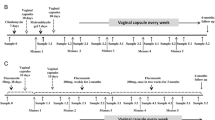Abstract
The present study was conducted in order to determine the prevalence of vaginal colonization by Candida spp in elderly residents of a long-term-care hospital and to examine the determinants of vaginal candidiasis. Vaginal swabs for Gram stain and culture were obtained from 106 bedridden residents of a long-term-care hospital (study group; mean age, 83±7 years) and a control group of 50 similarly aged women admitted to an acute-care hospital for non-genital problems (mean age, 81±8 years). The characteristics of patients who tested positive for Candida spp were compared with those who tested negative. Candida spp were isolated from 34 (32%) patients in the study group and from four (8%) control patients (p=0.001). In the study group, Candida glabrata was by far the most common species isolated (51.2%). The warm and moist environment in the perineal area created by diaper use in incontinent individuals, together with decubitus ulcers and immobilization, which are common in elderly patients receiving long-term care, might be responsible for the high occurrence of vaginal colonization with Candida in these women.
Similar content being viewed by others
References
Reed BD (1992) Risk factors for Candida vulvovaginitis. Obstet Gynecol 47:551–560
Sobel JD (1993) Genital candidiasis. In: Bodey GP (ed) Candidiasis: pathogenesis, diagnosis and treatment. Raven, New York, pp 225–247
Sobel JD (1997) Vaginitis. N Engl J Med 337:1896–1903
Fricker-Hidalgo H, Orenga S, Lebeau B, et al (2001) Evaluation of Candida ID, a new chromogenic medium for fungal isolation and preliminary identification of some yeast species. J Clin Microbiol 39:1647–1649
Hillier SL, Lau J (1997) Vaginal microflora in postmenopausal women who have not received estrogen replacement therapy. Clin Infect Dis 25 (Suppl):123–126
Spinillo A, Bernuzzi AM, Cevini C, Gulminetti R, Luzi S, De Santolo A (1997) The relationship of bacterial vaginosis, Candida and trichomonas infection to symptomatic vaginitis in postmenopausal women attending a vaginitis clinic. Maturitas 27:253–260
Bauters TGM, Dhont MA, Temmerman MIL, Nelis HJ (2002) Prevalence of vulvovaginal candidiasis and susceptibility to fluconazole in women. Am J Obstet Gynecol 187:569–574
Spinillo A, Capuzzo E, Egbe TO, Baltaro F, Nicola S, Piazzi G (1995) Torulopsis glabrata vaginitis. Obstet Gynecol 85:993–998
Fidel Jr PL, Vazquez JA, Sobel JD (1999) Candida glabrata: review of epidemiology, pathogenesis, and clinical disease with comparison to C. albicans. Clin Microbiol Rev 12:80–96
Geiger AM, Foxman B, Sobel JD (1999) Chronic vulvovaginal candidiasis: characteristics of women with Candida albicans, C. glabrata and no Candida. Genitourin Med 1995 71:304–307
Author information
Authors and Affiliations
Corresponding author
Rights and permissions
About this article
Cite this article
Dan, M., Segal, R., Marder, V. et al. Candida colonization of the vagina in elderly residents of a long-term-care hospital. Eur J Clin Microbiol Infect Dis 25, 394–396 (2006). https://doi.org/10.1007/s10096-006-0150-y
Published:
Issue Date:
DOI: https://doi.org/10.1007/s10096-006-0150-y




